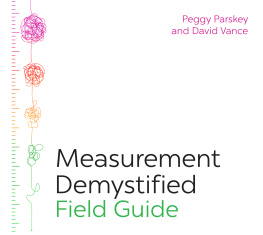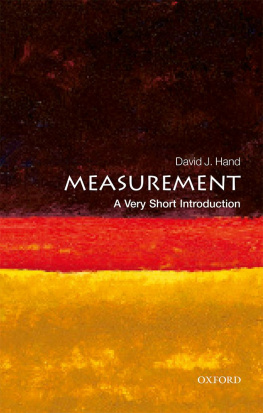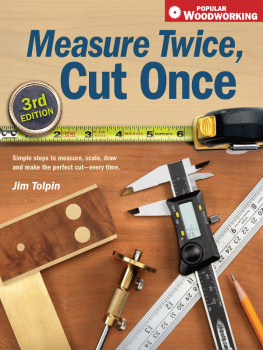First published in Great Britain in 2016 by
Michael OMara Books Limited
9 Lion Yard
Tremadoc Road
London SW4 7NQ
Copyright Michael OMara Books Limited 2016
All rights reserved. You may not copy, store, distribute, transmit, reproduce or otherwise make available this publication (or any part of it) in any form, or by any means (electronic, digital, optical, mechanical, photocopying, recording or otherwise), without the prior written permission of the publisher. Any person who does any unauthorized act in relation to this publication may be liable to criminal prosecution and civil claims for damages.
A CIP catalogue record for this book is available from the British Library.
ISBN: 978-1-78243-628-7 in hardback print format
ISBN: 978-1-78243-623-2 in ebook format
www.mombooks.com
For my ever-patient wife, Rhona, whose love and support over the past years defies measurement.
I n order to make sense of our own environment and that of the universe beyond, we need agreed scales of measurements which allow us to quantify the tangible and the intangible. Whether you are baking a cake or estimating the fuel requirements of a jumbo jet embarking on a transatlantic flight, you need a precise understanding of the volume of the raw materials involved and to be able to factor in variables of weight, time and temperature. You need measurements.
It wasnt until people abandoned nomadic lifestyles for settled communities that the need arose to measure. They had to measure out individual plots of land, which gave rise to basic geometry (from Greek ge, land, and -metria, a measuring of), and they needed to weigh out the grain they grew for sale or barter. The human body provided a ready, common scale, so horses were measured in hands (and still are, although the hand has been standardized to 4 inches), while different gauges were made by other body parts, such as the thumb, foot, forearm from fingertip to elbow and the span of outstretched arms. Each early settlement must have used a rock or stone as a grain weight hence the imperial weight unit of a stone but as this would have varied in size, standards to codify scales of weight and volume had to be introduced. As commerce expanded and found itself in need of employees, time itself had to be measured to make sure the labour force turned up on time and worked the agreed number of hours.
As with many other basic features of everyday life, such as language, regional codes of measurement developed into national ones, as it became essential to understand what vendors were offering and to have an appreciation of size and value. It may strike some readers that the following pages are biased towards the imperial and metric scales, but these are the measurements by which most of the world now runs. With the possible exception of the ancient Malay unit kati (600 g / 1 lb), which gave us the tea caddy, few exotic and obsolete measurements would even be recognized in their country of origin, so their inclusion in this book could hardly be justified.
Other current units no pun intended such as the volt, amp and ohm have also been excluded because, after the complexity of their definition is explained, there is little of interest to say about them. Much the same reasoning was behind the exclusion of units such as the pascal, the erg, the dyne and the atmosphere, which are more familiar in the fields of science and engineering than in everyday life.
The origins of many standard measurements are intriguing. The boxing ring became square and has the dimensions it does today because of the length of the four-horse coaching whip, while the shape and dimensions of the modern tennis court originate in the old manorial courtyard. Tennis somewhat eccentric scoring derives from the face of the old courtyard clock. But why are clock faces traditionally round? And what determined clockwise rotation? The answers lie in the sundial: had mechanical clocks been invented in the southern hemisphere, then clockwise would denote a rotation to the left.
European shoe sizes 38 or 40, for example equate to the number of barleycorns laid end to end, while the mile is based on one thousand (mille) full marching paces of a Roman legionary. The format of the periodic table was based on that of the card game solitaire, or patience. Zero degrees on the original Fahrenheit scale was determined by the temperature of ice in Danzig (now Gdask, Poland) during the unusually severe winter of 17089, while its upper marker of one hundred degrees was the temperature in Frau Fahrenheits armpit.
It is probably fair to say that we all take measurements for granted; a yard is a yard, a kilogram is a kilogram and so what? But as with so many other seemingly mundane subjects, when you delve into the history and origins of measurements you are in for more than a few surprises.
M easuring the height of anything is entirely dependent on which baseline you use. When it comes to mountains, it is customary to record the height in feet or metres above sea level, which is all well and good, but specifies neither the body of water being taken as the benchmark, nor the time of year. The surface height of all bodies of water changes quite significantly by the hour, due to tides, and from week to week due to shifts in planetary and lunar orbits. Nova Scotias Minas Basin, for example, has a tidal range of twelve to fifteen metres or forty to fifty feet, as has the Severn Estuary, which lies between England and South Wales.
To solve this problem, the scientific collective opted for mean sea level as measured at the midpoint between high and low tides but, again, different nations took their readings from different bodies of water.
In 1915, the UK fixed the mean sea level as the mid-tide point in Cornwalls Newlyn Harbour, which is fine for measuring peaks and promontories throughout the UK but not much use for measuring those in other lands. When you see a height claiming to be an accurate measure in feet or metres above sea level, you have to ask which sea was taken as the baseline and in which month that mean level was established. This is necessary even if the figures quoted are based on satellite readings, as all seas are in a permanent state of flux.
YOU CAN FEEL THE EARTH MOVE!
Most people imagine that tides are an exclusively oceanic phenomenon for which the moon alone is responsible, but the sun too plays a significant part with its own gravitational pull. Combined, these two heavenly bodies have no trouble in pulling ripples on the land masses.
Known as earth tides, these ripples can lift the surface by as much as 55 cm / 22 in. at the equator, with about 15 cm / 6 in. of that figure attributable to solar pull. Opinion in the relevant scientific sectors is divided as to the degree to which these ripples are responsible for seismic and volcanic activity.

MOUNT EVEREST

Arguably the worlds highest mountain, this was known by Victorians as Peak XV. As far as they were aware, the now iconic mountain was a modest promontory with its own base over 17,000 ft / 5,182 m up the Tibetan Plateau. From its base to its peak, Mount Everest is only about 12,000 ft / 3,658 m, but it has the unfair advantage of sitting atop the Himalayan massif. The tallest free-standing mountain is Africas Mount Kilimanjaro at 19,340 ft / 5,895 m.



















